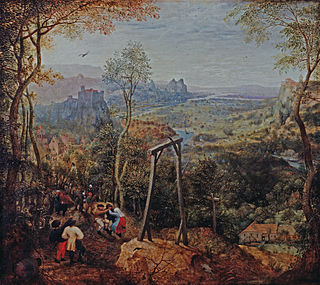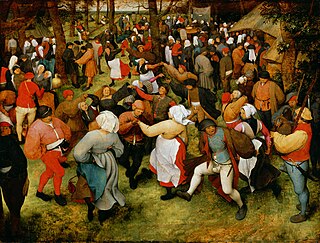
Pieter Brueghelthe Younger was a Flemish painter known for numerous copies after his father Pieter Bruegel the Elder's work, as well as original compositions and Bruegelian pastiches. The large output of his studio, which produced for the local and export market, contributed to the international spread of his father's imagery.

Pieter Bruegelthe Elder was among the most significant artists of Dutch and Flemish Renaissance painting, a painter and printmaker, known for his landscapes and peasant scenes ; he was a pioneer in presenting both types of subject as large paintings.

The Fight Between Carnival and Lent was painted by Pieter Bruegel the Elder in 1559. It is a panorama of contemporary life in the Southern Netherlands. While the painting contains nearly 200 characters, it is unified under the theme of the transition from Shrove Tuesday to Lent, the period forty days before Easter.

Landscape with the Fall of Icarus is a painting in oil on canvas measuring 73.5 by 112 centimetres now in the Royal Museums of Fine Arts of Belgium in Brussels. It was long thought to be by the leading painter of Dutch and Flemish Renaissance painting, Pieter Bruegel the Elder. However, following technical examinations in 1996 of the painting hanging in the Brussels museum, that attribution is regarded as very doubtful, and the painting, perhaps painted in the 1560s, is now usually seen as a good early copy by an unknown artist of Bruegel's lost original, perhaps from about 1558. According to the museum: "It is doubtful the execution is by Bruegel the Elder, but the composition can be said with certainty to be his", although recent technical research has re-opened the question.

The Magpie on the Gallows is a 1568 oil-on-wood panel painting by the Netherlandish Renaissance artist Pieter Bruegel the Elder. It is now in the Hessisches Landesmuseum in Darmstadt.

The Hunters in the Snow, also known as The Return of the Hunters, is a 1565 oil-on-wood painting by Pieter Bruegel the Elder. The Northern Renaissance work is one of a series of works, five of which still survive, that depict different times of the year. The painting is in the collection of the Kunsthistorisches Museum in Vienna, Austria. This scene is set in the depths of winter during December/January.

Marten van Cleve the Elder was a Flemish painter and draftsman active in Antwerp between 1551 and 1581. Van Cleve is mainly known for his genre scenes with peasants and landscapes, which show a certain resemblance with the work of Pieter Bruegel the Elder. Marten van Cleve was one of the leading Flemish artists of his generation. His subjects and compositions were an important influence on the work of Pieter Brueghel the Younger and other genre painters of his generation.

The Blind Leading the Blind, Blind, or The Parable of the Blind is a painting by the Netherlandish Renaissance artist Pieter Bruegel the Elder, completed in 1568. Executed in distemper on linen canvas, it measures 86 cm × 154 cm. It depicts the Biblical parable of the blind leading the blind from the Gospel of Matthew 15:14, and is in the collection of the Museo di Capodimonte in Naples, Italy.

Abel Grimmer was a Flemish late Renaissance painter, mainly of landscapes and, to a lesser extent, of architectural paintings. His works were important in the development towards more naturalism in Flemish landscape painting.

Peeter Baltens, Pieter Balten or Pieter Custodis, was a Flemish Renaissance painter, draughtsman, engraver and publisher. Baltens was also active as an art dealer and poet. He was known for his genre paintings, religious compositions and landscapes.

The Misanthrope is a tempera painting on canvas by the Flemish Renaissance artist Pieter Bruegel the Elder, created in 1568. It currently is held and exhibited at the National Museum of Capodimonte in Naples, Italy.

The Adoration of the Kings is an oil-on-panel painting of the Adoration of the Magi by the Netherlandish Renaissance artist Pieter Bruegel the Elder, painted in 1564, and now in the National Gallery, London.

The Peasant Dance is an oil-on-panel by the Netherlandish Renaissance artist Pieter Bruegel the Elder, painted in circa 1567. It was looted by Napoleon Bonaparte and brought to Paris in 1808, being returned in 1815. Today it is held by and exhibited at the Kunsthistorisches Museum in Vienna.

Conversion of Paul is an oil-on-panel by the Netherlandish Renaissance artist Pieter Bruegel the Elder, painted in 1567. It is currently held and exhibited at the Kunsthistorisches Museum in Vienna.

The Procession to Calvary is an oil-on-panel by the Netherlandish Renaissance artist Pieter Bruegel the Elder of Christ carrying the Cross set in a large landscape, painted in 1564. It is in the Kunsthistorisches Museum in Vienna.

The Peasant and the Nest Robber is an oil-on-panel painting by the Netherlandish Renaissance artist Pieter Bruegel the Elder, painted in 1568. It is in the Kunsthistorisches Museum in Vienna.

The Fall of the Rebel Angels is an oil-on-panel painting of 1562 by the Netherlandish Renaissance artist, Pieter Bruegel the Elder. The painting is 117cm x 162cm and is now in the Royal Museums of Fine Arts of Belgium in Brussels, Belgium. The Fall of Rebel Angels depicts Lucifer along with the other fallen angels that have been banished from heaven. Angels are falling from the sun in a stacked manner along with ungodly creatures that Bruegel created. This piece by Bruegel was previously thought to be by Hieronymus Bosch. Bruegel was influenced by a variety of artists such as Albrecht Dürer, Frans Floris I, and Hieronymus Bosch. He also got ideas for the creation of his creatures in his previous works.

The Census at Bethlehem is an oil-on-panel by the Flemish Renaissance artist Pieter Bruegel the Elder, painted in 1566. It is signed and measures about 1155 × 1645 mm. It is currently held and exhibited at the Royal Museums of Fine Arts of Belgium in Brussels, which acquired it in 1902. It is one of the first paintings in Western art to feature a significant snow landscape and was painted in the aftermath of the winter of 1565, which was one of the harshest winters on record.

The Wedding Dance is a 1566 oil-on-panel painting by Pieter Bruegel the Elder. Owned by the museum of the Detroit Institute of Arts in Detroit, Michigan, the work was discovered by its director in England in 1930, and brought to Detroit. It is believed to be one of a set of three Bruegel works from around the same time: The Wedding Dance, The Peasant Wedding (1567) and The Peasant Dance (1569).

Several oil-on-oak-panel versions of The Massacre of the Innocents were painted by 16th-century Netherlandish painters Pieter Bruegel the Elder and his son Pieter Brueghel the Younger. The work translates the Biblical account of the Massacre of the Innocents into a winter scene in the Netherlands in the prelude to the Dutch Revolt against Spanish rule, also known as the Eighty Years' War.





















